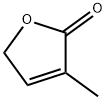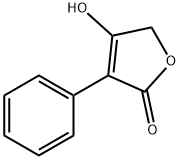VULPINIC ACID
- CAS NO.:521-52-8
- Empirical Formula: C19H14O5
- Molecular Weight: 322.31
- MDL number: MFCD00075804
- EINECS: 208-314-1
- SAFETY DATA SHEET (SDS)
- Update Date: 2023-06-08 09:02:50

What is VULPINIC ACID?
Description
Vulpinic acid is a lichen metabolite that has been found in L. vulpina and has diverse biological activities. It is active against C. perfringens, B. vulgatus, B. fragilis, B. loescheii, P. acnes, E. faecium, and methicillin-susceptible and -resistant S. aureus (MICs = 4-16 μg/ml). Vulpinic acid (25-800 μM) prevents UVB-induced apoptosis, cytotoxicity, and cytoskeletal modifications in HaCaT human keratinocytes. It also increases scratch wound healing of HaCaT cells. Vulpinic acid (15 μM) reduces hydrogen peroxide-induced production of reactive oxygen species (ROS) and cytotoxicity in human umbilical vein endothelial cells (HUVECs).
Chemical properties
Yellow Solid
The Uses of VULPINIC ACID
A lichen metabolite with anti-inflammatory properties
The Uses of VULPINIC ACID
antiinflammatory, antibacterial, plant growth inhibitor
The Uses of VULPINIC ACID
A lichen metabolite with anti-inflammatory properties.
What are the applications of Application
Vulpinic acid is a lichen metabolite with anti-inflammatory properties
Definition
ChEBI: Vulpinic acid is a butenolide.
Properties of VULPINIC ACID
| Melting point: | 146-148°C |
| storage temp. | -20°C Freezer |
| solubility | Acetonitrile (Slightly, Heated), Chloroform (Slightly), DMSO (Slightly), Methano |
| form | Solid |
| color | Yellow |
Safety information for VULPINIC ACID
Computed Descriptors for VULPINIC ACID
New Products
Tert-butyl bis(2-chloroethyl)carbamate (S)-3-Aminobutanenitrile hydrochloride N-Boc-D-alaninol N-BOC-D/L-ALANINOL 3-(2,4-Dimethoxybenzyl)dihydropyrimidine-2,4(1H,3H)-dione 7-Bromo-1H-indazole N-octanoyl benzotriazole 3,4-Dibenzyloxybenzaldehyde 4-Hydrazinobenzoic acid Electrolytic Iron Powder Fmoc-Val-Cit-PAB 1,1’-CARBONYLDIIMIDAZOLE R-2-BENZYLOXY PROPIONIC ACID 4-HYDROXY BENZYL ALCOHOL 1,1’-CARBONYLDI (1,2-4 TRIAZOLE) S-2-CHLORO PROPIONIC ACID (2-Hydroxyphenyl)acetonitrile 4-Bromopyrazole 5-BROMO-2CYANO PYRIDINE 5,6-Dimethoxyindanone 5-broMo-2-chloro-N-cyclopentylpyriMidin-4-aMine 1-(4-Methylphenylsulfonyl)-1H-1,2,3-benzotriazole 1-(2-Chlorobenzyl)-4-nitro-1H-pyrazole 1-(2-Nitrophenyl)-4-phenylpiperazineRelated products of tetrahydrofuran








You may like
-
 Vulpinic Acid CAS 521-52-8View Details
Vulpinic Acid CAS 521-52-8View Details
521-52-8 -
 55441-95-7 2 2-BIS(2-HYDROXYETHOXY)-1 1-BINAPHTHYL 99%View Details
55441-95-7 2 2-BIS(2-HYDROXYETHOXY)-1 1-BINAPHTHYL 99%View Details
55441-95-7 -
 Ste-Glu-AEEA-AEEA-OSUView Details
Ste-Glu-AEEA-AEEA-OSUView Details
1169630-40-3 -
 1446013-08-6 Fmoc-His-Aib-OH TFA 98%View Details
1446013-08-6 Fmoc-His-Aib-OH TFA 98%View Details
1446013-08-6 -
 127464-43-1 99%View Details
127464-43-1 99%View Details
127464-43-1 -
 Chloro Uracil 99%View Details
Chloro Uracil 99%View Details
1820-81-1 -
 2-ETHYLPYRIDINE 100-71-0 99%View Details
2-ETHYLPYRIDINE 100-71-0 99%View Details
100-71-0 -
 13162-05-5 99%View Details
13162-05-5 99%View Details
13162-05-5